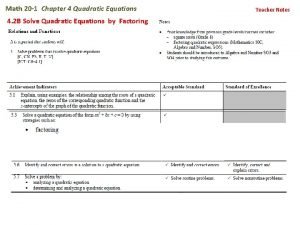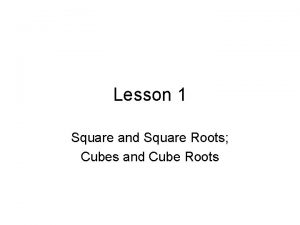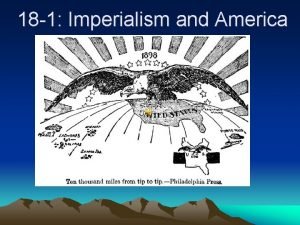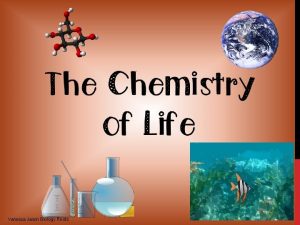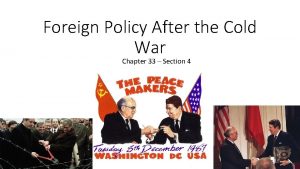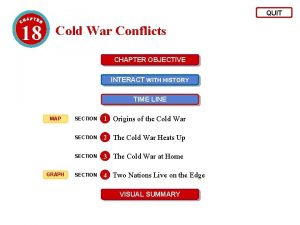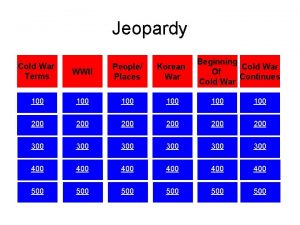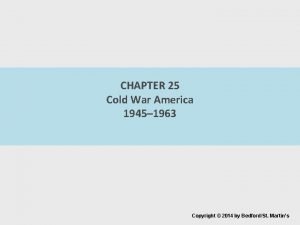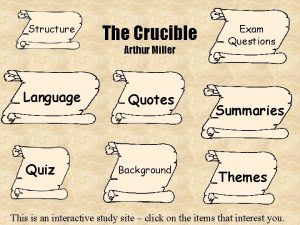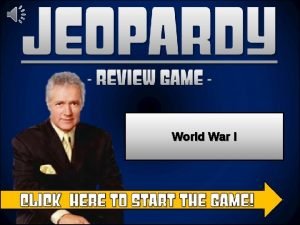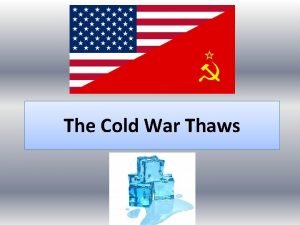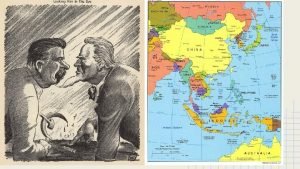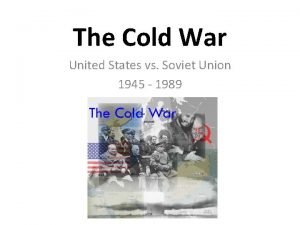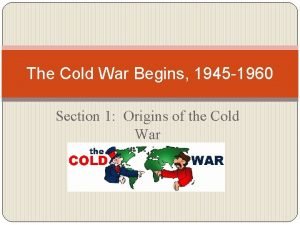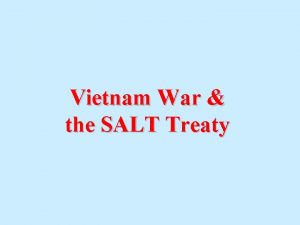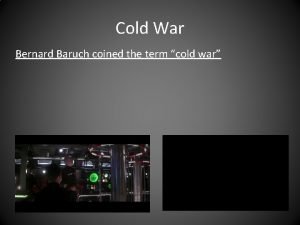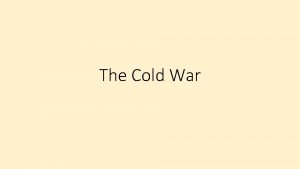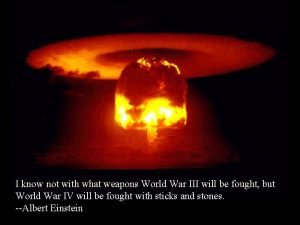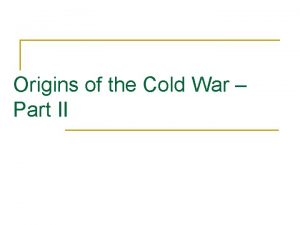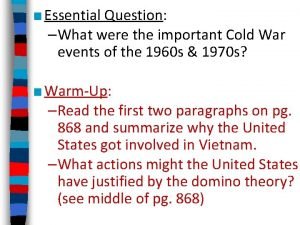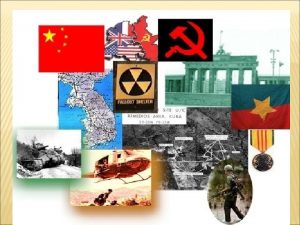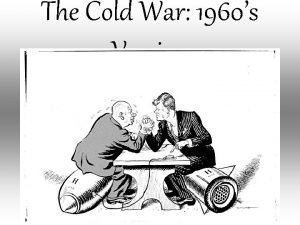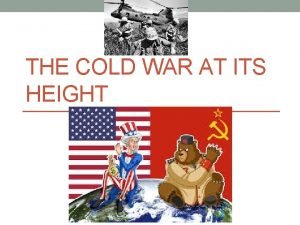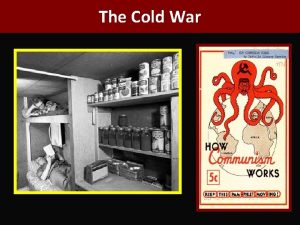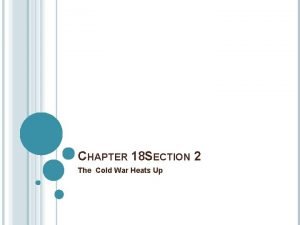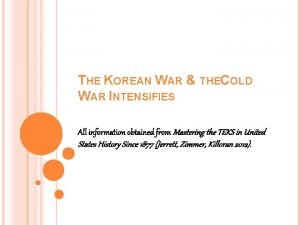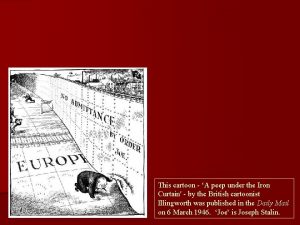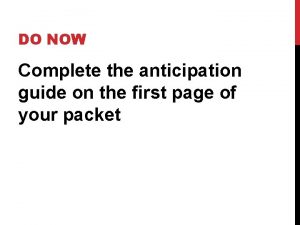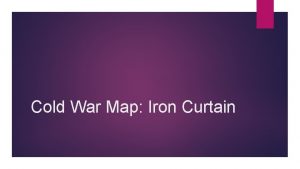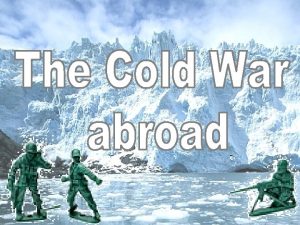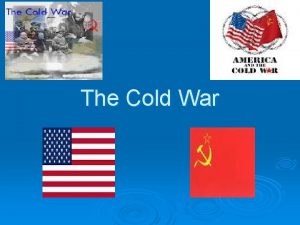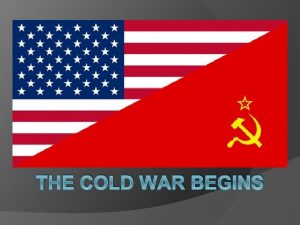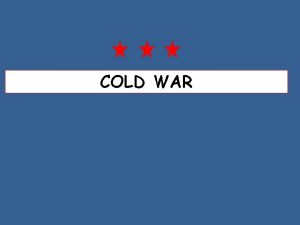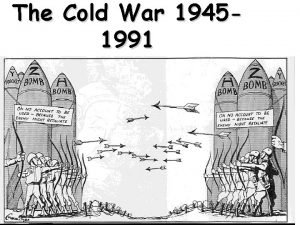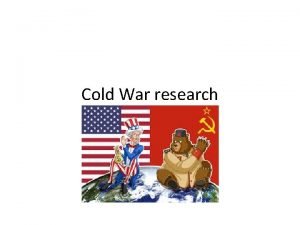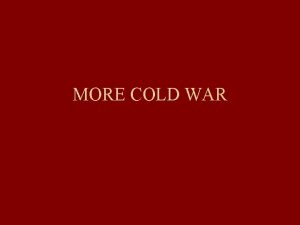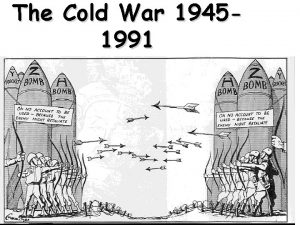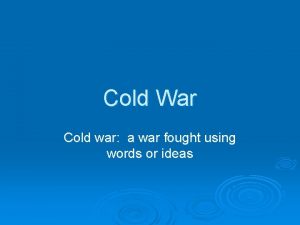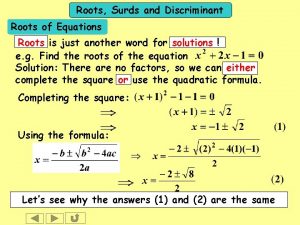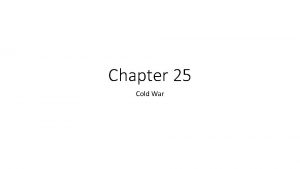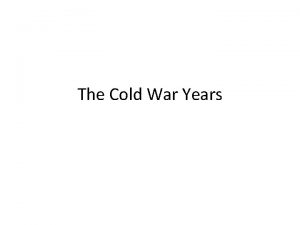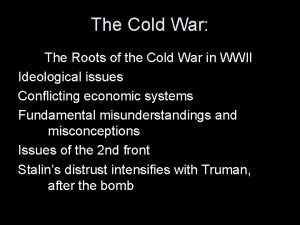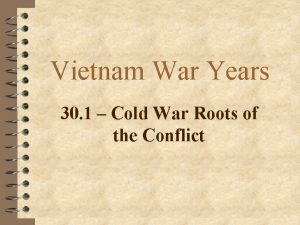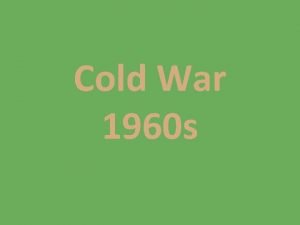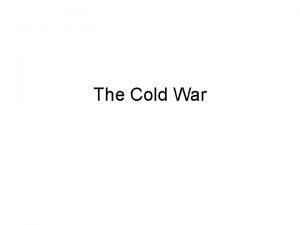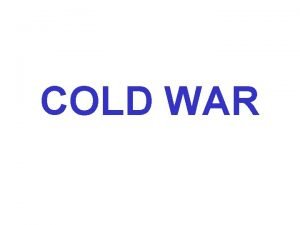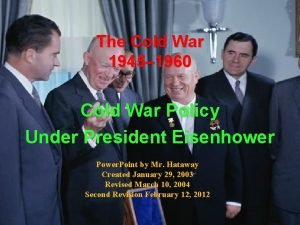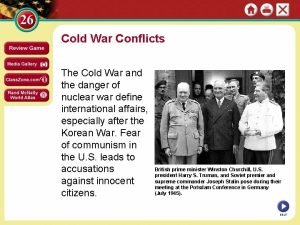The Cold War 1 Roots of the Cold

















































- Slides: 49

The Cold War

1. Roots of the Cold War ► At the end of WW 2, the United States and Russia were left as the world’s two major powers ► U. S. had vast economic power and the Atomic Bomb ► Russian had the massive Red Army ► They were known as the Superpowers

1. Roots of the Cold War ► Even though the United States and Russia had been allies- their different political, economical, and social systems caused them to disagree. ► After the war, each power attempted to extend its influence in Europe and then in Asia, Latin America and Africa.

1. Roots of the Cold War ► Western nations that agreed with the U. S. hoped to spread democracy and free enterprise. ► Soviet Leaders promoted the spread of Communism. ► This caused competition among the different governments.

2. The Cold War Begins In Europe ► Yalta Conference split up Germany into four separate zones of occupation ► Controlled by U. S, Great Britain, France and Soviet Union ► Stalin pledged to allow Free Elections in Eastern Europe when the war ended. ► Stalin did not keep his promise.

2. The Cold War Begins In Europe ► Soviet army occupied eastern Europe and placed local Communists in power. ► Stalin finally had his “buffer” he believed that the USSR deserved. ► Winston Churchill announced that an “Iron Curtain” had descended on Eastern Europe.


2. The Cold War Begins In Europe ► Nations of Albania, Bulgaria, Czechoslovakia, Hungary, Poland, Rumania, and, later, East Germany became Soviet satellites. ► Trade and Communication cut off between Eastern and Western Europe. ► Eastern European governments forced to create Communist economies and follow USSR Policies

3. Growing American Involvement ► Western Leaders feared that Stalin was another Hitler. ► U. S. was the only country powerful enough to resist the Soviet Union and the Spread of Communism

3. Growing American Involvement ► In 1947, Britain withdrew troops from Greece from fear of Communist Rebels. ► President Truman sends aid to Greece and Turkey to stop Communist Rebellion. ► He then offered to support all free people who resist Communism

3. Growing American Involvement ► This created a policy known as the “Truman Doctrine” ► Marked the beginning of American Containment Policy ► It said that the United States would not overturn Communism where it already existed, but would stop it from spreading any further.


3. Growing American Involvement ► Later that year, the US announced the Marshall Plan ► It gave billions of dollars in aid to Western European nations to rebuild their war-torn economies. ► Plan was to build more trade partners and help governments from turning to “other” economic systems.

3. Growing American Involvement ► The Berlin Airlift and the Division of Germany ► In 1948, Western allies began to merge their zones of occupation in Germany ► Stalin reacted by closing all Western highway and railroad links to Berlin ► Western allies then began massive airlift to feed and supply city

3. Growing American Involvement ► Within a year, Stalin admitted defeat and lifted the blockade. ► In 1949, the three Western zones of occupation officially merged into a new independent state known as the Federal Republic of Germany (West Germany) ► Stalin Responded by turning the Soviet Zone into German Democratic Republic (East Germany


4. Formation of Nato and Warsaw Pact ► In 1949, the United States, Canada, and ten Western European countries formed the North Atlantic Treaty Organization ► NATO was formed to protect Western Europe from Communist aggression. ► U. S. pledged to defend Western Europe with its nuclear weapons.

4. Formation of Nato and Warsaw Pact ► Soviet Leaders responded in 1955 by creating the Warsaw Pact with their Eastern European Allies. ► Hungary tried to drop out, so Soviet forces moved in to “crush the uprisings”


5. Cold War Reaches Asia ► Chiang Kai-Shek had defeated local Warlords and united most of China in 1928. ► Engaged in long struggle with both Chinese Communists and Japanese Invaders. ► Communist Leader Mao Zedong had to retreat his forces in the Long March to Northwestern China

5. Cold War Reaches Asia ► In 1937, Japan invaded China. ► Nationalist and Communist come together to fight the invaders. ► When Japan was defeated, they resumed their fight. ► Soviet Union provides help to Communist rebels by helping them gain the peasant support with land reform policies.

5. Cold War Reaches Asia ► In 1949, Mao Zedong and the Communist gained control ► Chiang retreated to the island of Taiwan, vowing to return.

6. Red Star Over China ► Mao Zedong emphasized the role of the peasantry ► Also made such changes as: § Eliminated “Capitalist Class” § Reeducation of Communist Beliefs § Family authority was replaced by authority of the Communist Party. Abolished Ancestor Worship.


7. The Great Leap Forward ► In 1956, Mao started forcing farmers into cooperative farms. § Families shared work and split crops ► They were later merged in to larger Communes

7. The Great Leap Forward ► In 1958, Mao introduced a Five-Year Plan aimed at turning China into an Industrial Power. ► China’s Vast Population was used to build dams, roads, and factories. ► But Poor Planning caused overspending which led to economic disaster and starvation with up to 30 -50 million died.

The Korean War ► Mao’s victory only strengthened the fears of Communism spreading. ► Like Germany, Korea was divided in 1945. ► Korea was divided into a Communist North and Democratic South. ► In 1950, Communist North Korea invades South Korea

The Korean War ► President Truman kept his promise and came to help of South Korea ► Under a United Nations Resolution, the U. S. and other countries came to force the Communist Back ► The United Nations forces were led by General Douglas Mac. Arthur and invaded North Korea

The Korean War ► When the war approached Chinese border, China itself intervened. ► Mac. Arthur wanted to use Nuclear weapons on China, so Truman removed him from command ► In 1953, a compromise ended the war leaving North and South Korea exactly where they started.

The Cultural Revolution ► By 1962, border disputes and Mao’s dislike of reforms in the Soviet Union caused an open disagreement. ► Mao used this Sino-Soviet split to bid for world leadership of the Communist movement.

The Cultural Revolution ► Mao wanted to boost enthusiasm of party official and cover up his failures from the Great Leap Forward ► Mao pushed China towards what he called the Cultural Revolution ► Mao’s sayings from his “Little Red Book” served as the Blue Print.

The Cultural Revolution ► In 1966, Mao closed China’s universities and schools and invited eleven million students to gather in Beijing as Red Guards ► Used Red Guards to attack intellectuals that looked down on the common man ► Scholars were sent to farms and old Chinese culture destroyed

The Cultural Revolution ► Mao opponents were removed, imprisoned, tortured, and killed ► Eventually Red Guards were out of control and needed military to control them. ► Once again this policy led to food shortages ► In 1969, Red Guard were sent to Farms ► That ended the violence but as many as one million people died.

Cambodia ► Withdrawal of American Forces from Vietnam led to collapse of Cambodian government. ► In 1975, the Khmer Rouge (Cambodian Communist took control ► Their leader, Pol Pot carried out the policy of genocide of 4 million city dwellers and opponents. ► In 1978, finally overthrown by Vietnamese.


The Cold War Ends

Soviet Stagnation ► After Khrushchev fell in 1964, the Soviet Union fell into a period of stagnation (no growth) ► Supplies could not keep up with Population ► Unable to compete with free-market economies of the West. ► Soviet Party members getting special privileges

Soviet Stagnation ► Soviet leaders tried the policy of detente to ease tensions. ► Rebellions in Czechoslovakia in 1968 and Afghanistan in 1979 ended that policy. ► Natan Sharansky, founder of Refusenik Movement, was imprisoned for demanding human rights for nine years.

The Gorbachev Years ► In 1985, Mikhail Gorbachev became the leader of the Soviet Union ► Instituted three major reforms ►Glasnost- “Greater Openness” Lifted restrictions on media, borders, and communications with West. ►Perestroika-”Restructuring” of economic policies, promoted individuals owning small businesses ►Foreign Policy-began negotiations with U. S. to reduce nuclear arms and allow Eastern European countries to create Democratic Countries


The Iron Curtain Falls In Eastern Europe ► In 1978, Pope John Paul II was the first non Italian Pope elected in 400 years. ► Inspired Polish people to lead the way for the demand of change. ► Lech Walesa organized independent trade union. ► Government tried to crush movement, but the strike of the Gdansk shipyard caused it to spread through Poland.

The Iron Curtain Falls In Eastern Europe ► Poland became first Eastern European Government to become non-Communist ► The idea of free government spread to other Eastern European Governments who then left communism too. ► In 1989, the Berlin Wall was opened for the first time since 1961.

Gorbachev’s Problems Grow ► Gorbachev’s policies were failing to maintain control ► Nationalism became to spread again, with Boris Yelton being elected President of the Russian Republic. ► Gorbachev was helpless to stop them.

The Dissolution of the Soviet Union ► August 1991, hardcore Communists stage a military coup to overthrow Gorbachev. ► Lacking popular support, the coup collapsed ► Discredited the communist even more. ► Gorbachev tried to negotiate a new arrangement for the Soviet Union but in December 1991, it collapsed

The Dissolution of the Soviet Union ► Russia, Belarus, and the Ukraine all declared their independence. ► They formed the Commonwealth of Independent States ► They were independent but served the group in limited functions ► Gorbachev resigned at the 1991 and the U. S. S. R was no more.

The Reunification of Germany ► When the Soviet Union fell, German reunited. ► Helmet Kohl, West Germany’s Leader, helped negotiate the reunification, which became official at the end of 1990. ► After half a century of division, Germany was once again a united nation

Changes Come to China ► After Mao’s Death, Deng Xiaoping became China’s leader. ► Introduced free enterprise slowly without losing monopoly on government power. ► Wanted to “modernize” China by reforming its economy.

Tiananmen Square and the Limits of Reform ► In 1989, Chinese college students peacefully demonstrated in Beijing’s Tiananmen Square. ► Wanted greater personal freedom and democracy. ► When they wouldn’t leave, army tanks fired of the demonstrators, killing hundreds. ► Western leaders reduced trade for incident but trade has resumed.

Tiananmen Square
 The cold war lesson 1 the cold war begins
The cold war lesson 1 the cold war begins Fought
Fought Roots of a quadratic equation
Roots of a quadratic equation Square roots notes
Square roots notes Perfect cube list
Perfect cube list Lesson 3 existence and uniqueness
Lesson 3 existence and uniqueness The roots of american imperialism 1. economic roots
The roots of american imperialism 1. economic roots Vanessa jason biology roots answer key
Vanessa jason biology roots answer key Tug of war or tug-of-war
Tug of war or tug-of-war Chapter 30 the war to end war
Chapter 30 the war to end war Reconstruction venn diagram
Reconstruction venn diagram Past simple ge
Past simple ge Civil war first modern war
Civil war first modern war Why was josette dugas for the war of 1812
Why was josette dugas for the war of 1812 Toward civil war lesson 3 secession and war
Toward civil war lesson 3 secession and war War at home and abroad madison
War at home and abroad madison Sein datid
Sein datid Chapter 30 the war to end war
Chapter 30 the war to end war Korean war vietnam war venn diagram
Korean war vietnam war venn diagram Free verse poetry
Free verse poetry Chapter 33 section 4 foreign policy after the cold war
Chapter 33 section 4 foreign policy after the cold war Cold war tension graph
Cold war tension graph Why did stalin want to create a “buffer zone”?
Why did stalin want to create a “buffer zone”? Chapter 25 cold war america
Chapter 25 cold war america Cold war
Cold war 2 sides of cold war
2 sides of cold war World war one jeopardy
World war one jeopardy The cold war thaws
The cold war thaws The cold war vocab
The cold war vocab Soviet
Soviet The cold war begins 1945-1960
The cold war begins 1945-1960 What does salt stand for cold war
What does salt stand for cold war What started the cold war
What started the cold war Cold war knowledge organiser
Cold war knowledge organiser Was the cold war capitalism vs communism
Was the cold war capitalism vs communism Chapter 17 section 1 cold war two superpowers face off
Chapter 17 section 1 cold war two superpowers face off Cold war 1947
Cold war 1947 Weapons of the cold war diagram
Weapons of the cold war diagram Origins of the cold war
Origins of the cold war Brinkmanship cold war
Brinkmanship cold war Communism cold war
Communism cold war Cold war
Cold war When was the height of the cold war
When was the height of the cold war Cold war vocabulary
Cold war vocabulary Characteristics of cold war
Characteristics of cold war The cold war heats up chapter 18 section 2
The cold war heats up chapter 18 section 2 Thecold war
Thecold war Who is peeping under the iron curtain
Who is peeping under the iron curtain Cold war anticipation guide
Cold war anticipation guide Cold war map iron curtain
Cold war map iron curtain


